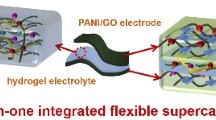Abstract
Based on the noncovalent functionalization of ferrocene-grafted polyethylenimine (PEI-Fc) and carbon nanotubes (CNTs), CNT bundles are exfoliated by PEI-Fc solution and thus form stable compounds PEI-Fc@CNTs, which is used to construct the PEI-Fc@CNTs/DNA multilayers through layer-by-layer assembly. The multilayers show a highly uniform and homogeneous characteristic, which significantly improve the electrical property of the multilayers. Upon the oxidation electrical potential, the ferrocene groups are switched from reduction state ([Fe(C5H5)2]) to oxidation state ([Fe(C5H5)2]+), leading to change of microenvironments’ charge density, resulting in swelling of the multilayers and a final degree of swelling of 37 % and the decrease of multilayer stiffness. We maintain that electrochemical control over the swelling behavior of multilayers could have important implications for responsive coatings of nanoscale devices, including mechanically tunable surfaces which are used to modulate cellular activities and control drug delivery.







Similar content being viewed by others
References
Goldman R, Pollack S (1996) Electric fields and proliferation in a chronic wound model. Bioelectromagnetics 17:450–457
Ciombor DM, Aaron RK (1993) Influence of electromagnetic fields on endochondral bone formation. J Cell Biochem 52:37–41
Politis MJ, Zanakis MF (1989) The short-term effects of delayed application of electric fields in the damaged rodent spinal cord. Neurosurgery 25:71–75
Hou C, Duan Y, Zhang Q et al (2012) Bio-applicable and electroactive near-infrared laser-triggered self-healing hydrogels based on graphene networks. J Mater Chem 22:14991–14996
Liu Y, Hu J, Zhuang X et al (2012) Synthesis and characterization of novel biodegradable and electroactive hydrogel based on aniline oligomer and gelatin. Macromol Biosci 12:241–250
Shang J, Shao Z, Chen X (2008) Chitosan-based electroactive hydrogel. Polymer 49:5520–5525
Cui HT, Wang Y, Cui L G et al (2014) In vitro studies on regulation of osteogenic activities by electrical stimulus on biodegradable electroactive polyelectrolyte multilayers. Biomacromolecules 15:3146–3157
Sun YX, Ren KF, Zhao YX et al (2013) Construction of redox-active multilayer film for electrochemically controlled release. Langmuir 29:11163–11168
Sun YX, Ren KF, Wang JL et al (2013) Electrochemically controlled stiffness of multilayers for manipulation of cell adhesion. ACS Appl Mater Interfaces 5:4597–4602
Guo CX, Yang HB, Sheng ZM et al (2010) Layered graphene/quantum dots for photovoltaic devices. Angew Chem Int Ed 49:3014–3017
Lin Y, Taylor S, Li H et al (2004) Advances toward bioapplications of carbon nanotubes. J Mater Chem 14:527–541
Artyukhin AB, Shestakov A, Harper J et al (2005) Functional one-dimensional lipid bilayers on carbon nanotube templates. J Am Chem Soc 127:7538–7542
Li J, Srivastava S, Ok JG et al (2011) Multidirectional hierarchical nanocomposites made by carbon nanotube growth within layer-by-layer-assembled films. Chem Mater 23:1023–1031
Yuan J, Wang Z, Zhang Y et al (2008) Electrostatic layer-by-layer a of platinum-loaded multiwall carbon nanotube multilayer: a tunable catalyst film for anodic methanol oxidation. Thin Solid Films 516:6531–6535
Mamedov AA, Kotov NA, Prato M et al (2002) Molecular design of strong single-wall carbon nanotube/polyelectrolyte multilayer composites. Nat Mater 1:190–194
Jan E, Kotov NA (2007) Successful differentiation of mouse neural stem cells on layer-by-layer assembled single-walled carbon nanotube composite. Nano Lett 7:1123–1128
Jan E, Pereira FN, Turner DL et al (2011) In situ gene transfection and neuronal programming on electroconductive nanocomposite to reduce inflammatory response. J Mater Chem 21:1109–1114
Cai X, Gao X, Wang L et al (2013) A layer-by-layer assembled and carbon nanotubes/gold nanoparticles-based bienzyme biosensor for cholesterol detection. Sensor Actuat B Chem 181:575–583
Karousis N, Tagmatarchis N, Tasis D (2010) Current progress on the chemical modification of carbon nanotubes. Chem Rev 110:5366–5397
Zhu L, Shangguan Y, Sun Y et al (2010) Rheological properties of redox-responsive, associative ferrocene-modified branched poly (ethylene imine) and its modulation by β-cyclodextrin and hydrogen peroxide. Soft Matter 6:5541–5547
Yuan WZ, Sun JZ, Liu JZ et al (2008) Processable hybrids of ferrocene-containing poly (phenylacetylene) s and carbon nanotubes: fabrication and properties. J Phys Chem B 112:8896–8905
Yuan WZ, Sun JZ, Dong Y et al (2006) Wrap** carbon nanotubes in pyrene-containing poly (phenylacetylene) chains: solubility, stability, light emission, and surface photovoltaic properties. Macromolecules 39:8011–8020
Moya SE, Ilie A, Bendall JS et al (2007) Assembly of polyelectrolytes on CNTs by van der Waals interactions and fabrication of LBL polyelectrolyte/CNT composites. Macromol Chem Phys 208:603–608
Mamedov AA, Kotov NA, Prato M et al (2002) Molecular design of strong single-wall carbon nanotube/polyelectrolyte multilayer composites. Nat Mater 1:190–194
Mulchandani A, Wang CL, Weetall HH (1995) Amperometric detection of peroxides with poly (anilinomethylferrocene)-modified enzyme electrodes. Anal Chem 67:94–100
Bakker E, Telting-Diaz M (2002) Electrochemical sensors. Anal Chem 74:2781–2800
Tagmatarchis N, Prato M (2004) Functionalization of carbon nanotubes via 1,3-dipolar cycloadditions. J Mater Chem 14:437–439
Grieshaber D, Voros J, Zambelli T et al (2008) Swelling and contraction of ferrocyanide-containing polyelectrolyte multilayers upon application of an electric potential. Langmuir 24:13668–13676
Schmidt DJ, Cebeci FC, Kalcioglu ZI et al (2009) Electrochemically controlled swelling and mechanical properties of a polymer nanocomposite. ACS Nano 3:2207–2216
Forzani ES, Pérez MA, Teijelo ML et al (2002) Redox driven swelling of layer-by-layer enzyme-polyelectrolyte multilayers. Langmuir 18:9867–9873
Zahn R, Vörös J, Zambelli T (2010) Swelling of electrochemically active polyelectrolyte multilayers. Curr Opin Colloid Interface Sci 15:427–434
Acknowledgments
This work was supported by the National Natural Science Foundation of China (21174126, 51333005, 21374095), the National Basic Research Program of China (2011CB606203), Research Fund for the Doctoral Program of Higher Education of China (20110101110037, 20120101130013), the Qianjiang Excellence Project of Zhejiang Province (2013R10035), and International Science & Technology Cooperation Program of China (2014DFG52320).
Conflict of interest
The authors declare that they have no conflict of interest.
Author information
Authors and Affiliations
Corresponding authors
Electronic supplementary material
Below is the link to the electronic supplementary material.
About this article
Cite this article
Sun, YX., Ren, KF., Chang, GX. et al. Enhanced electrochemical stimuli multilayers based on a ferrocene-containing polymer. Sci. Bull. 60, 936–942 (2015). https://doi.org/10.1007/s11434-015-0780-5
Received:
Accepted:
Published:
Issue Date:
DOI: https://doi.org/10.1007/s11434-015-0780-5




